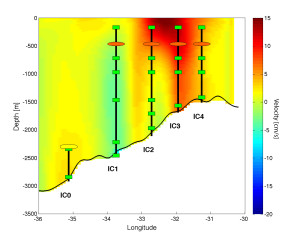By Laura de Steur
After having spent a couple of days at sea – which were very welcome in order to get used to the sea state, which was, fortunately, not too bad after the storm we had in Reykjavik – it is our turn to start with the actual deployments of the ocean moorings. The first ones to go in are the Dutch ones in the northward flowing Irminger Current which carries warm and saline Atlantic Water northward on the western side of the Reykjanes Ridge. Part of the Irminger Current continues northward, past Iceland, into the Iceland Sea, while the other part flows counter-clockwise towards Greenland, and on to the south again. Four moorings are planned on the slope of the ridge at bottom depths ranging from 2500 to 1400 m (see figure below). With this array we want to determine the year-round volume and heat transport of the Irminger Current south of Iceland. In addition, and thanks to each institute chipping in either an instrument, buoy or cable we managed to get a fifth mooring together. This one is placed just at the bottom of the ridge at about 2900 m to capture the dense, deep boundary current as well.
What does a typical deep-ocean mooring look like in our case: since we want to know all about velocities, temperature and salinity, we have on it current meters, some of them are Acoustic Doppler Current Profilers (ADCPs) which can cover a whole range (up to 600 m) of the water column, or some are point current meters to obtain velocities at a single depth, and there are so called Microcats; very nice, small but sturdy, instruments which measure temperature, salinity and pressure, typically every 15 minutes during the coming year. In order to keep the mooring in position we use a heavy anchor – basically scrap steel like old train wheels, or a bunch of steel welded together – which is attached to acoustic releases, that is, a set of two which will let go of the anchor in a year’s time when we want to get the mooring back after we’ve buy lexapro online sent an acoustic command to it. These releases are fixed to the bottom of a coated steel wire on which all the instruments are attached at different depths, determined beforehand. Finally, the whole mooring is kept up right in the water with floatation, that is, either a whole set of buoys up to 50 m below the surface, or in our (the Dutch) case, a large single buoy – orange, of course…
As a nice break we were hoping to catch some of the Dutch playing against Argentina: Go Holland! But of course, after having had pretty good access earlier on, the internet was completely out at 8 pm when we were all set to watch, or listen to it. We even dressed in orange. Luckily the second mate managed to get a signal on the radio so there we were four of us (that is Leon, marine technician at NIOZ, Marco, and Maurits, students from Utrecht University, and myself) congregated on the bridge to try to understand anything of the British commentary in between heavy noise of the radio signal. Perhaps we did not get too much of it, but one thing became clear: no goals for the Netherlands…
After a nice warm up deploying the first mooring, we are getting the hang of it and do about two a day – easily. This is only possible because of darn good team work together with the ship’s crew. That is, all on deck helping out with the winch, crane, A-frame, anchors, tightening bolts, etc and not to be forgotten, the officers on the bridge who maneuver the ship exactly there such that after the anchor is dropped from the back of the ship the mooring will – at least we hope – get right on the position where we want it, which by the way, was not very easily determined on a volcanic ridge with tons of little and big crests and troughs. Then on July 11th the 5th Irminger Current mooring goes in, and yes, luckily that is a better score than the Dutch had against Argentina. Oh well, at least now we do not have to worry about missing the final…
[portfolio_slideshow id=354]
